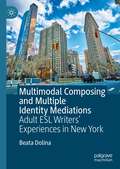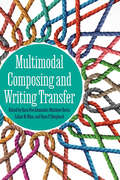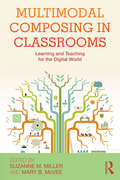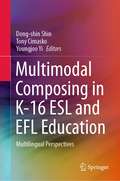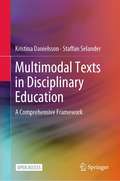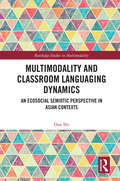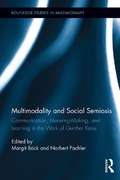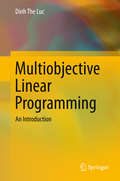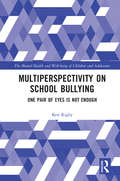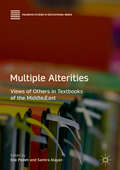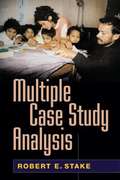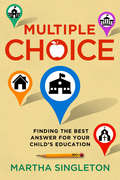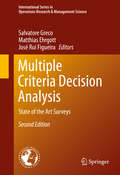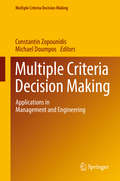- Table View
- List View
Multimodal Approaches to Research and Pedagogy: Recognition, Resources, and Access (Routledge Studies in Multimodality)
by Denise Newfield Arlene ArcherThis book brings together social semiotics, cultural studies, multiliteracies, and other approaches in order to theorize very different learning environments, giving visibility to the modal effect in a range of disciplines. It highlights the ideological nature of discursive practices, examines questions of access, and argues for transformation of these practices, with a constant eye on issues of social justice and equity. Contributors argue that we can harness learners’ representational resources through making these resources visible, and creating less regulated spaces in the curriculum in which they can be used. Examples from primary education through to adult continuing education are used throughout the text.
Multimodal Composing and Multiple Identity Mediations: Adult ESL Writers' Experiences in New York
by Beata DolinaThis book examines the experiences of adult ESL (English as a Second Language) learners in New York, paying particular attention to the relationship between their professional identities and multimodal composing practices in English classroom. The author uses an (auto-)ethnographic framework to investigate how previously-constructed identities of a professional nature aided the students in the design of multimodal texts including photographs and written material in English. This small-scale study is contextualised in relation to current research in the fields of multimodality, identity construction and teaching methodology, and the author also draws on Kress' theory of visual semiotics. Finally, the book provides detailed descriptions and suggestions for multimodal lessons which could be delivered in ESL classrooms in other settings, including multimodal roleplays, theatre games, and model discussion questions and answers. This book will be of interest to ESL/EFL and TESOL researchers and practitioners, as well as pre-service teachers and MA TESOL students.
Multimodal Composing and Writing Transfer
by Matthew Davis Lilian W. Mina Kara Poe AlexanderMultimodal Composing and Writing Transfer explores transfer across various contexts of multimodal composing, extending the early conversations connecting multimodality to writing. Contributors address how writing transfer theories intersect with multimodal composing and present methods for facilitating transfer across modes and media, offering insight into how writers can learn to compose when they encounter familiar modes in new contexts. Over the past two decades the concepts of multimodal composing and writing transfer have grown and reshaped the nature of writing studies, but rarely have the ways in which these areas overlap been studied. This collection shows how this shift in writing studies has been mutually informative, covering a wider range of contexts for multimodality and writing transfer than just in first-year composition courses. It places composition teaching practices and multimodal research in conversation with learning transfer theory to provide an in-depth examination of how they influence one another. Multimodal Composing and Writing Transfer develops these intersections to connect multimodal composition and writing practices across a wide array of fields and contexts. Scholars across disciplines, postsecondary writing teachers, writing program administrators, writing center directors, and graduate students will find this collection indispensable.
Multimodal Composing in Classrooms: Learning and Teaching for the Digital World
by Suzanne M. Miller Mary B. McVeeTaking a close look at multimodal composing as an essential new literacy in schools, this volume draws from contextualized case studies across educational contexts to provide detailed portraits of teachers and students at work in classrooms. Authors elaborate key issues in transforming classrooms with student multimodal composing, including changes in teachers, teaching, and learning. Six action principles for teaching for embodied learning through multimodal composing are presented and explained. The rich illustrations of practice encourage both discussion of practical challenges and dilemmas and conceptualization beyond the specific cases. Historically, issues in New Literacy Studies, multimodality, new literacies, and multiliteracies have primarily been addressed theoretically, promoting a shift in educators’ thinking about what constitutes literacy teaching and learning in a world no longer bounded by print text only. Such theory is necessary (and beneficial for re-thinking practices). What Multimodal Composing in Classrooms contributes to this scholarship are the voices of teachers and students talking about changing practices in real classrooms.
Multimodal Composing in K-16 ESL and EFL Education: Multilingual Perspectives
by Dong-Shin Shin Tony Cimasko Youngjoo YiThis book offers a comprehensive view of multimodal composing and literacies in multilingual contexts for ESL and EFL education in United States of America and globally. It illustrates the current state of multimodal composing and literacies, with an emphasis on English learners' language and literacy development. The book addresses issues concerning multilinguals' multimodal composing and reflects on what the nexus of multimodality, writing development, and multilingual education entails for future research. It provides research-driven and practice-oriented perspectives of multilinguals' multimodal composing, drawing on empirical data from classroom contexts to elucidate aspects of multimodal composing from a range of theoretical perspectives such as multiliteracies, systemic functional linguistics, and social semiotics. This book bridges the gap among theory, research, and practice in TESOL and applied linguistics. It serves as a useful resource for scholars and teacher educators in the areas of applied linguistics, second language studies, TESOL, and language education.
Multimodal Conversation Analysis and Interpretative Phenomenological Analysis: A Methodological Framework for Researching Translanguaging in Multilingual Classrooms (Qualitative and Visual Methodologies in Educational Research)
by Kevin W. TaiThis book presents the methodological framework of combining Multimodal Conversation Analysis (MCA) with Interpretative Phenomenological Analysis (IPA) to interpretively analyse translanguaging practices in educational contexts. Beginning with an overview of the three uses of translanguaging—translanguaging as a theory of language, as a pedagogical practice, and as an analytical perspective—the book goes on to critically examine the different methodological approaches for analysing translanguaging practices in multilingual classroom interactions. It explains how MCA and IPA are useful methodologies for understanding how and why translanguaging practices are constructed by participants in the classroom and discusses types of data collected and data collection procedures. The author, Kevin W. H. Tai, shows how combining these approaches enables researchers to study how translanguaging practices are constructed in multilingual classrooms and how teachers make sense of their own translanguaging practices at particular moments of classroom interaction. This detailed and concise guide is indispensable for students, practitioners, policymakers, and researchers from across the globe, particularly those working in the fields of applied linguistics and language education.
Multimodal Funds of Knowledge in Literacy: Countering Deficit Narratives of Diverse Families
by Sally Brown Rong ZhangApplying an asset-based approach, Multimodal Funds of Knowledge in Literacy prepares educators to teach and support diverse students and their families as they negotiate multimodal aspects of literacy learning. Framed by sociocultural theory, multiliteracies, multimodality, and posthumanism, the text combats deficit narratives by providing concrete alternatives that push educators to rethink their practices and support students’ and families’ cultural and linguistic strengths.Chapters include case studies, vignettes, prompts, and learning samples that will leave readers with valuable insights and new understandings of multimodal funds of knowledge. Comprehensive and instructive, this book is a key text in literacy education, family literacy, and community engagement.
Multimodal Learning Environments in Southern Africa: Embracing Digital Pedagogies (Digital Education and Learning)
by Jako Olivier Avinash Oojorah Waaiza UdhinThis book offers an important overview of technology-enhanced education in Southern Africa. With original research from Malawi, Mauritius, Namibia, South Africa, Tanzania and Zimbabwe, this book provides in-depth scientific scholarship focused on the dynamic multimodal learning environments in the region. With the onset of the COVID-19 pandemic, the world has largely had to adjust to remotelearning. Hence, the editors and contributors pull together important research on digital pedagogies and assessment to demonstrate how technology can be effectively employed for multimodal learning environments within the Southern African context. This book will be of interest and value to scholars of digital education, multimodal learning and education within Southern Africa and beyond.
Multimodal Literacy in School Science: Transdisciplinary Perspectives on Theory, Research and Pedagogy
by Paul Chandler Russell Tytler Len Unsworth Sally Humphrey Lisl Fenwick Michele Herrington Lam PhamThis book establishes a new theoretical and practical framework for multimodal disciplinary literacy (MDL) fused with the subject-specific science pedagogies of senior high school biology, chemistry and physics. It builds a compatible alignment of multiple representation and representation construction approaches to science pedagogy with the social semiotic, systemic functional linguistic-based approaches to explicit teaching of disciplinary literacy. The early part of the book explicates the transdisciplinary negotiated theoretical underpinning of the MDL framework, followed by the research-informed repertoire of learning experiences that are then articulated into a comprehensive framework of options for the planning of classroom work. Practical adoption and adaptation of the framework in biology, chemistry and physics classrooms are detailed in separate chapters. The latter chapters indicate the impact of the collaborative research on teachers' professional learning and students’ multimodal disciplinary literacy engagement, concluding with proposals for accommodating emerging developments in MDL in an ever-changing digital communication world. The MDL framework is designed to enable teachers to develop all students' disciplinary literacy competencies. This book will be of interest to researchers, teacher educators and postgraduate students in the field of science education. It will also have appeal to those in literacy education and social semiotics.
Multimodal Pedagogies in Diverse Classrooms: Representation, Rights and Resources
by Pippa SteinMultimodal Pedagogies in Diverse Classrooms examines how the classroom can become a democratic space founded on the integration of different histories, modes of representation, feelings, languages and discourses, and is essential reading for anyone interested in the connection between multimodality, pedagogy, democracy and social justice in diverse classrooms. Pippa Stein combines theory with material taken from post-apartheid classrooms in South Africa where students from different language and cultural backgrounds negotiate the ongoing tensions between tradition and modernity, Western and African intellectual thought, as well as the apartheid-past of their parents, and their own aspirations for the future. This insightful book argues that classrooms can become ‘transformative’ sites in which students can develop curricula and pedagogies which speak to the diversity of global societies, and looks at: How multimodality can be used to promote social justice and democracy in diverse classrooms; The forms of representation through which students make meaning in classrooms; How those forms contribute to the building of democratic cultures; The cultural resources available to students, and how they are used for learning; Difference as a productive energy for learning. Dealing with issues such as democracy, politics of difference, diversity, multicultural and multilingual classrooms, this book is as pertinent to readers across the globe as it is to those in South Africa, and will be invaluable and fascinating reading for anyone working or interested in this field.
Multimodal Perspectives of Language, Literacy, and Learning in Early Childhood
by Marilyn J. NareyOur image-rich, media-dominated culture prompts critical thinking about how we educate young children. In response, this volume provides a rich and provocative synthesis of theory, research, and practice that pushes beyond monomodal constructs of teaching and learning. It is a book about bringing "sense" to 21st century early childhood education, with "sense" as related to modalities (sight, hearing), and "sense" in terms of making meaning. It reveals how multimodal perspectives emphasize the creative, transformative process of learning by broadening the modes for understanding and by encouraging critical analysis, problem solving, and decision-making. The volume's explicit focus on children's visual texts ("art") facilitates understanding of multimodal approaches to language, literacy, and learning. Authentic examples feature diverse contexts, including classrooms, homes, museums, and intergenerational spaces, and illustrate children's "sense-making" of life experiences such as birth, identity, environmental phenomena, immigration, social justice, and homelessness. This timely book provokes readers to examine understandings of language, literacy, and learning through a multimodal lens; provides a starting point for constructing broader, multimodal views of what it might mean to "make meaning;" and underscores the production and interpretation of visual texts as meaning making processes that are especially critical to early childhood education in the 21st century.
Multimodal Texts in Disciplinary Education: A Comprehensive Framework
by Kristina Danielsson Staffan SelanderThis open access book provides an introduction to multimodality and the role of multimodal texts in today’s education. Presenting a comprehensive framework for analysing and working with multimodal texts in disciplinary education, it serves as a tool for researchers and teachers alike. The second part of the book focuses on sample analyses of a variety of educational texts for different age groups and from different disciplines, including games and online resources. The authors also comment on the specific challenges of each text, and how teachers can discuss such texts with their students to enhance both their understanding of the content and their multimodal literacy. The book is intended for researchers in fields like education and multimodal studies, and for teacher educators, regardless of school subject or age group. With the combined perspectives on text analysis and implications for education, the book addresses the needs of teachers who want to work with multimodal aspects of texts in education in informed ways, but lack the right tools for such work.
Multimodality and Classroom Languaging Dynamics: An Ecosocial Semiotic Perspective in Asian Contexts (Routledge Studies in Multimodality)
by Dan ShiThis practical analytical guide to classroom languaging dynamics in L2 tertiary classrooms integrates multimodality, sociological theory of education and ecosocial semiotic perspectives. It offers a theoretical and methodological framework for conducting multimodal analysis of meaning-making processes in different pedagogical settings. The multimodal investigation of real-time classroom interactivity showcases an embodied coordination of vocalization and gesticulation in classroom interactions, where it varies from students’ solo speech in individual presentations, to teacher-student interactions in group discussions, and to student-student interactions in role-play. With a unified conceptual framework articulating both the macro and micro analysis, this book proposes more ecological-based approaches to language and unpacks a multi-scalar analytical framework to open up for an embodied analysis of meaning-making processes in multimodal interaction analysis. The rich systematic analysis built upon the ecosocial semiotic approach illustrates in practice how theoretical frameworks link to empirical data analysis through exemplified analytical processes and practices, and demonstrates the value of how multimodal interaction analysis contributes to the understanding of the cognitive dynamics of languaging activities that take place in L2 educational contexts. The book provides not only a practical methodological guide to multimodal interaction analysis, but also hands-on analytical references to multimodal classroom research in the field. In addition to early career scholars and PhD students, this volume will be valuable for international academics looking for complementary frameworks or approaches to multimodality, particularly in the L2 Asian contexts.
Multimodality and Social Semiosis: Communication, Meaning-Making, and Learning in the Work of Gunther Kress (Routledge Studies in Multimodality)
by Norbert Pachler Margit BöckGunther Kress, one of the founders of social semiotics and multimodality, has made lasting contributions to these fields through his work in semiotics and meaning-making; power and identity; agency, design, production; and pedagogy and learning; in varied sites of transformation. This book brings together leading scholars in a variety of disciplines, including social semiotics, pedagogy, linguistics, media and communication studies, new literacy studies, ethnography, academic literacy, literary criticism and, more recently, medical/clinical education, to examine and build upon his work. This disciplinary diversity is evidence of the ways in which Kress' work has influenced and been influenced by a wide range of academic work and intellectual endeavors and how it has been used to lay foundations for theory-building and concept development in a varied yet connected range of areas. The individual contributions to the book pick up the threads of the often collaborative work of the authors with Kress; they show how these approaches were subsequently developed and discuss what future trajectories the authors see for them.
Multimodality, Digitalization and Cognitivity in Communication and Pedagogy (Numanities - Arts and Humanities in Progress #20)
by Natalya V. Sukhova Tatiana Dubrovskaya Yulia A. LobinaThis book positions itself at the intersection of the key areas of the modern humanities. Different authors from a variety of countries take innovative approaches to investigating multimodal communication, adapting pedagogical design to digital environments and enhancing cognitive skills through transformations in teaching and learning practices. The eclectic forms under study require eclectic approaches and methodologies, and the authors cross disciplinary boundaries drawing on philosophy, linguistics, semiotics, computational linguistics, mathematics, cognitive studies and neuroaesthetics. Part I presents methods of analysing multimodal communication in its different displays, covering promotional video in crowdfunding project presentations, multimodal public signs of prohibition and visuals as arguments. Part II explores varied teaching methodologies that have emerged as a result of and in response to modern technological changes and contains some practical hints for educators. It demonstrates the pedagogical potential of video games, virtual worlds, linguistic corpora and online dictionaries. Part III focuses on psychological and cognitive factors influencing success in the classroom, primarily, ways of developing students’ and teachers’ personalities. The volume sits at the intersection between Communication Studies, Digital Humanities, Discourse Analysis, Education Theory and Cognitive Studies and is useful to scholars and students of communication, languages, education and other areas of the humanities. This book should trigger scholarly discussions as well as stimulating practitioners’ interest in these fields.
Multiobjective Linear Programming
by Dinh The LucThis book introduces the reader to the field of multiobjective optimization through problems with simple structures, namely those in which the objective function and constraints are linear. Fundamental notions as well as state-of-the-art advances are presented in a comprehensive way and illustrated with the help of numerous examples. Three of the most popular methods for solving multiobjective linear problems are explained, and exercises are provided at the end of each chapter, helping students to grasp and apply key concepts and methods to more complex problems. The book was motivated by the fact that the majority of the practical problems we encounter in management science, engineering or operations research involve conflicting criteria and therefore it is more convenient to formulate them as multicriteria optimization models, the solution concepts and methods of which cannot be treated using traditional mathematical programming approaches.
Multiperspectivity on School Bullying: One Pair of Eyes is Not Enough (The Mental Health and Well-being of Children and Adolescents)
by Ken RigbyMultiperspectivity on School Bullying is unique in providing a comprehensive account of school bullying from the perspectives of schools, teachers, parents, students and institutional authorities. It identifies diverse viewpoints and discusses their implications for addressing bullying and thereby improving the mental health and well-being of children. Drawing on findings from studies conducted in a wide range of countries, including those undertaken by the author in his own country, Australia, this book examines experiences of bullying and debates around how bullying can be best understood, managed and discouraged. It outlines what is needed before an agreed understanding of the problem can be reached and more effective anti-bullying programs devised and implemented. The book examines both historical and cultural factors relating to bullying and violence; major theoretical and research perspectives on bullying; views of different social groups affected by bullying; and how different institutional authorities view school bullying. It highlights the need for a multiperspectivity approach to bullying, taking into account and evaluating a variety of viewpoints that are currently held. This book will be of great interest to academics, researchers and students in the fields of bullying, wellbeing and mental health in schools. It will also be valuable reading for educational leaders around the globe.
Multiple Alterities
by Elie Podeh Samira AlayanThis book highlights and examines the role of the textbook in legitimising established political and social orders. It analyses the way in which the 'other' is presented in school textbooks, focusing on a number of countries in the Middle East and North Africa (MENA) region, and argues that the role of textbooks in developing and maintaining a national identity should be afforded greater critical attention. Textbooks can help form national identities by developing a society's collective memory; this might involve a historical narrative which may be self-contradictory or even fabricated to a certain extent, including myths, symbols and collective memories that divide "us" from "them", and ultimately resulting a dichotomy between the Self and the Other. As well as addressing a range of theoretical questions relating to the study of textbooks generally, the volume also covers a broad spectrum of Middle Eastern states and societies, with contributions from Turkey, Iran, Egypt, Cyprus, Lebanon, Iraq, Kurdistan, Jordan, Morocco, Tunisia, Israel and Palestine. It will be essential reading for researchers and students working in the fields of Education, Sociology and History, particularly those with an interest in national identities in the MENA region.
Multiple Case Study Analysis
by Robert E. StakeExamining situational complexity is a vital part of social and behavioral science research. This engaging text provides an effective process for studying multiple cases--such as sets of teachers, staff development sessions, or clinics operating in different locations--within one complex program. The process also can be used to investigate broadly occurring phenomena without programmatic links, such as leadership or sibling rivalry. Readers learn to design, analyze, and report studies that balance common issues across the group of cases with the unique features and context of each case. Three actual case reports from a transnational early childhood program illustrate the author's approach, and helpful reproducible worksheets facilitate multicase recording and analysis.
Multiple Choice And Free Response Questions In Preparation For The AP English Language And Composition Examination (5th Edition)
by Richard Vogel Charles F. WinansHelp with language arts
Multiple Choice and Free Response Questions in Preparation for the AP U. S. Government and Politics Examination (6th Edition)
by Ethel Wood Bonnie HerzogThis book assists students in assessing their level of understanding of both basic concepts and factual information in United States government and politics. The questions simulate as closely as possible the AP United States Government and Politics Examination administered each year in May by the College Board.
Multiple Choice and Free-Response Questions in Preparation for the AP English Language and Composition Examination (6th Edition)
by Richard VogelThis book has been designed to help students prepare for the Advanced Placement Exam in English Language and Composition. It is not filled with definition of literary terms nor saccharine advice on how to 'psych' students up for the examination. Rather, its passages are selected and its questions designed with the singular purpose of developing in students the habits of mind that good readers possess, that they actively employ while reading, and that they use to structure and develop their written responses to the text.
Multiple Choice: Finding the Best Answer for Your Child's Education
by Martha SingletonBecause no one answer is always right or always wrong for every child!When it comes to educating their kids, parents need to know that between home school, private Christian school, or public school, there’s no one right answer.As a practical guide in making that all-important decision, Multiple Choice helps parents assess each child’s learning style and their family’s goals for education. It objectively examines both the benefits and drawbacks of each form of schooling. Interviews with education professors, teachers, parents, and students who have participated in each venue combine to make this an engaging guide for parents as they make important choices for their child’s future. An easy read, this book includes tips and ideas for things parents can do at home to increase the effectiveness of their child's education, sources for further reading, and guiding questions. Multiple Choice empowers parents to make informed decisions and to be effectively engaged in their child’s learning and spiritual growth on a daily basis.
Multiple Criteria Decision Analysis
by Matthias Ehrgott Salvatore Greco José Rui FigueiraIn two volumes, this new edition presents the state of the art in Multiple Criteria Decision Analysis (MCDA). Reflecting the explosive growth in the field seen during the last several years, the editors not only present surveys of the foundations of MCDA, but look as well at many new areas and new applications. Individual chapter authors are among the most prestigious names in MCDA research, and combined their chapters bring the field completely up to date. Part I of the book considers the history and current state of MCDA, with surveys that cover the early history of MCDA and an overview that discusses the "pre-theoretical" assumptions of MCDA. Part II then presents the foundations of MCDA, with individual chapters that provide a very exhaustive review of preference modeling, along with a chapter devoted to the axiomatic basis of the different models that multiple criteria preferences. Part III looks at outranking methods, with three chapters that consider the ELECTRE methods, PROMETHEE methods, and a look at the rich literature of other outranking methods. Part IV, on Multiattribute Utility and Value Theories (MAUT), presents chapters on the fundamentals of this approach, the very well known UTA methods, the Analytic Hierarchy Process (AHP) and its more recent extension, the Analytic Network Process (ANP), as well as a chapter on MACBETH (Measuring Attractiveness by a Categorical Based Evaluation Technique). Part V looks at Non-Classical MCDA Approaches, with chapters on risk and uncertainty in MCDA, the decision rule approach to MCDA, the fuzzy integral approach, the verbal decision methods, and a tentative assessment of the role of fuzzy sets in decision analysis. Part VI, on Multiobjective Optimization, contains chapters on recent developments of vector and set optimization, the state of the art in continuous multiobjective programming, multiobjective combinatorial optimization, fuzzy multicriteria optimization, a review of the field of goal programming, interactive methods for solving multiobjective optimization problems, and relationships between MCDA and evolutionary multiobjective optimization (EMO). Part VII, on Applications, selects some of the most significant areas, including contributions of MCDA in finance, energy planning problems, telecommunication network planning and design, sustainable development, and portfolio analysis. Finally, Part VIII, on MCDM software, presents well known MCDA software packages.
Multiple Criteria Decision Making
by Constantin Zopounidis Michael DoumposThis book presents a broad range of innovative applications and case studies in all areas of management and engineering, including public administration, finance, marketing, engineering, transportation, and energy systems. It addresses issues related to problem structuring, preference modeling, and model construction, presenting a framework that provides clear decision-making support in practice. In addition, it includes hybrid and integrated techniques combining multiple criteria decision making (MCDM) with other analytical methods. The book reflects the growing impact of MCDM in the field of management science and operations research. Building on recent and established theoretical advances and presenting their applications in specific domains, it offers a comprehensive resource for researchers, graduate students and professionals alike.

